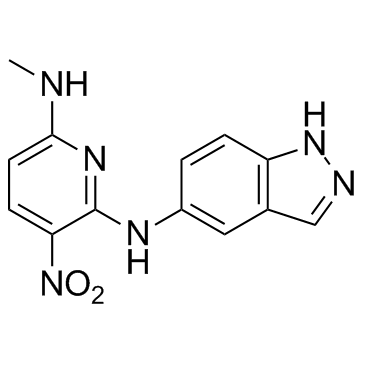342639-96-7
| Name | N2-(1H-Indazol-5-yl)-N6-methyl-3-nitro-2,6-pyridinediamine |
|---|---|
| Synonyms |
N-(1H-Indazol-5-yl)-N-methyl-3-nitro-2,6-pyridinediamine
2,6-Pyridinediamine, N-1H-indazol-5-yl-N-methyl-3-nitro- KRIBB11 |
| Description | KRIBB11 is an inhibitor of Heat shock factor 1 (HSF1), with IC50 of 1.2 μM. |
|---|---|
| Related Catalog | |
| Target |
HSF1:1.2 μM (IC50) |
| In Vitro | KRIBB11 blocks the induction of HSF1 downstream target proteins such as HSP27 and HSP70. KRIBB11 induces growth arrest and apoptosis of HCT-116 cells. KRIBB11 inhibits HSF1-dependent recruitment of p-TEFb (positive transcription elongation factor b) to the hsp70 promoter[1]. PARP and caspase-3 cleavage is increased in cells treated with KRIBB11. Incubating RKO with KRIBB11, shows a toxic threshold of about 10 µM, and an IC50 of 20-30 µM[2]. |
| In Vivo | KRIBB11 (50 mg/kg, i.p.) results in a 47.4% inhibition of tumor growth in nude mice, without body weight loss[1]. |
| Kinase Assay | HCT-116 cells are washed with PBS and then homogenized with a 27-gauge syringe in binding buffer (10 mm Tris-HCl (pH 7.4), 50 mm KCl, 5 mm MgCl2, 1 mm EDTA, and 0.1 mm Na3VO4). The cell lysate is centrifuged at 13,000 rpm for 30 min at 4°C, and the supernatant is collected. The HCT-116 cell lysate supernatant is precleared by incubating with Dynabeads M-280 streptavidin for 30 min at 4°C and captured by magnet separation. The cleared supernatants are incubated with biotinyl-KRIBB11 compound. After overnight incubation at 4°C, proteins associated with the biotinyl-KRIBB11 compound are precipitated with Dynabeads M-280 streptavidin. Precipitated samples are separated by a magnet. Samples are washed with 1 mL of ishing buffer containing 50 mm HEPES (pH 7.5), 50 mm NaCl, 1 mm EDTA, 1 mm EGTA, 0.1% Tween 20, 10% (v/v) glycerol, 1 mm NaF, 0.1 mm Na3VO4, and protease inhibitor mixture tablets (1 tablet/10 mL). Samples are boiled in SDS-PAGE sample buffer, separated by 10% polyacrylamide gel, and immunoblotted with antibodies against HSF1, HSF2, HSP90, or CDK9. |
| Cell Assay | Cells are seeded onto 96-well plates at a density of 6×103 cells per well in McCoy's 5A medium with 10% FBS. After 24 h, the medium is replenwashed with fresh complete medium containing chemicals or 0.1% DMSO. After incubation for 48 h, the cell proliferation reagent WST-1 is added to each well. The amount of WST-1 formazan produced is measured at 450 nm using an ELISA reader. |
| Animal Admin | Seven-week-old female inbred specific pathogen-free Balb/c nude mice are housed under sterile conditions with 12-h light/dark cycles, and fed food and water ad libitum. For the evaluation of the in vivo anti-tumor activity of KRIBB11, HCT-116 cells (0.3 mL of 4×107 cells/mL) are implanted subcutaneously into the right flank of the mice on day 0. KRIBB11 is dissolved in 10% dimethylacetamide, 50% PEG300, and 40% distilled water. When the size of tumors reached 72.2 mm3, the compound is administered intraperitoneally at a dose of 50 mg/kg/day for 18 days. Tumor volumes are estimated by using the formula length (mm) × width (mm) × height (mm)/2. To determine the toxicity of the compound, the body weight of tumor-bearing animals is recorded. On day 18, the mice are sacrificed, and the tumors are weighed. |
| References |
| Density | 1.5±0.1 g/cm3 |
|---|---|
| Boiling Point | 535.0±50.0 °C at 760 mmHg |
| Molecular Formula | C13H12N6O2 |
| Molecular Weight | 284.273 |
| Flash Point | 277.3±30.1 °C |
| Exact Mass | 284.102173 |
| LogP | 4.30 |
| Vapour Pressure | 0.0±1.4 mmHg at 25°C |
| Index of Refraction | 1.812 |
| Storage condition | -20℃ |
